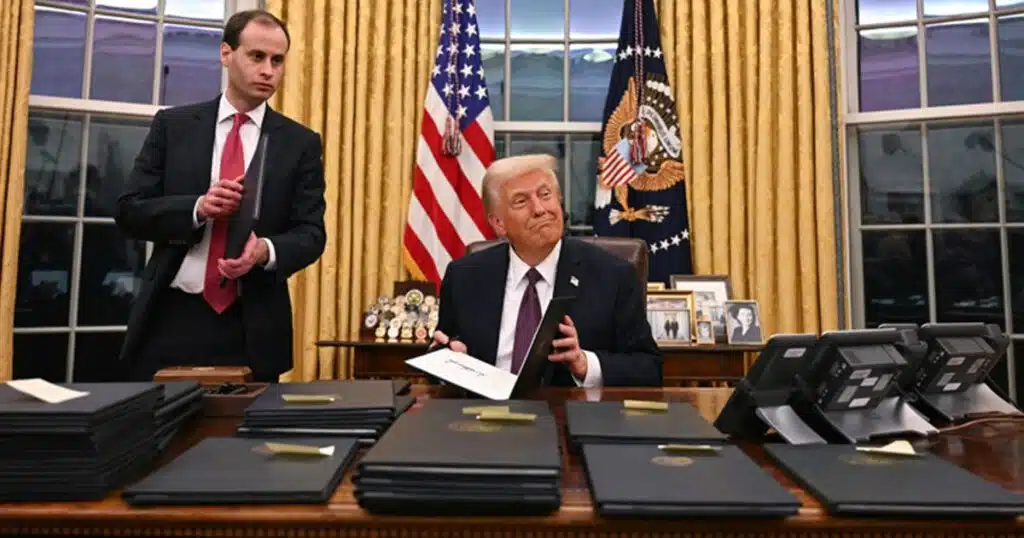
ALEXANDER: Biden Says The Quiet Part Out Loud On Abortion
Roe v. Wade was always a legally defective decision. And, in a maniacal effort to preserve the right “to abort a child,” the nation has witnessed in the last week the unprecedented breach of trust reflected in the release of a U.S. Supreme Court decision that apparently represents the Court’s analysis and decision on a case directly implicating America’s abortion law.
The leak has set off a torrent of attacks and recriminations about the continued existence of the “fundamental right” to abortion. It shouldn’t. The landmark 1973 Roe v. Wade abortion decision, and its equally flawed successor in abortion law, Planned Parenthood v. Casey, were always constitutionally defective in that these cases, as President Biden rightly acknowledges, create the legal right “to abort a child.”
In defending Roe last week, Biden said that “the idea that we’re going to make a judgment that is going to say that no one can make the judgment to choose to abort a child, based on a decision by the Supreme Court, I think goes way overboard.”
In addition to supporting violence and cruelty imposed without anesthetic on the weakest members of the human population, President Biden is wrong as a matter of constitutional law. Why do I say that? Because the right to abortion—the killing of an unborn child—is found nowhere in the Constitution or in our history or traditions.
Then, how did the 1973 Roe Court possibly find a ground upon which to base a so-called right to abortion? It made the “right” up out of whole cloth. As Yale scholar Alexander Bickel put it, the Roe Court “simply asserted the result it reached.” Other pro-abortion scholars have concluded similarly.
Harvard Law Professor Laurence Tribe has said that “One of the most curious things about Roe is that, behind its own verbal smokescreen, the substantive judgment on which it rests is nowhere to be found.” Supreme Court Justice Ruth Bader Ginsburg has said that Roe is “Heavy-handed judicial intervention [and] was difficult to justify and appears to have provoked, not resolved, conflict.”
Edward Lazarus, a former law clerk to Harry Blackmun, the author of Roe, said that “As a matter of constitutional interpretation and judicial method, Roe borders on the indefensible.” John Hart Ely, a Professor at Yale Law School, Harvard Law School, and Stanford Law School said that “Roe is not constitutional law and gives almost no sense of an obligation to try to be.”
In this article, I put aside the moral implications of abortion, which are vast and profound, and focus on the Roe decision strictly as a matter of constitutional law.
By engaging in clever reasoning and wordplay untethered to the Constitution, the Roe Court purported to examine the 14th Amendment and its “liberty” clause and from that concoct an abortion right from the so-called “right to privacy.” Over the years the Court has found that this right to privacy includes such liberties as the right to use contraceptives within marriage, child-rearing, private homosexual acts, gay marriage, and education. These rights are all clearly distinguishable from Roe in that Roe and Casey permit the destruction of what is scientifically and undeniably human life.
By including abortion in the privacy interest, the U.S. Supreme Court in Roe—seven unelected, life-tenured federal judges—took the issue away from the states and from the Congress and, moving well beyond its proper judicial role in our separation of powers, acted as a super-legislature and imposed on the nation its own social and cultural preferences regarding abortion. This is a highly illegitimate exercise of legal power. As noted, there is no explicit or implied Constitutional right to abort a human baby—a separate and genetically distinct human being.
The status of our scientific understanding of the humanity of the unborn child in 1973, when Roe was decided, has progressed light years since then. Roe functionally relies on Medieval science from the Dark Ages compared to the miracles of science today which continue to push the date of viability back farther and closer to conception and have resulted in surgeons’ ability to repair heart valve weaknesses and spina bifida while the baby is still in the womb. In truth, the question has never really been, When Does Life Begin? But rather, When Does Love Begin?
To put this in context it helps to recall that the framers of our Constitution intended to and thought they had created a system of federalism in which the states and the federal government co-exist, with the federal government deriving its powers from those ceded to it by the states.
The federal government would be one of limited, enumerated powers and could assert only those powers specifically granted by the Constitution. All other powers were reserved to the states and the people and any action by a state government was presumptively valid unless it violated some specific limitation imposed by the U.S. Constitution and the 10th Amendment. But in all instances, both the federal and state constitutions were dedicated to preserving “life, liberty, and the pursuit of happiness.”
Now, those who favor abortion will argue that the Roe decision is 49 years old and its holding has been reaffirmed in other cases since 1973 and, as such, the legal doctrine of Stare Decisis (which simply means that prior legal decisions should be maintained and not lightly overturned) won’t allow it to be overturned. I respectfully disagree.
While Stare Decisis is an important principle it is not sacred. It is not a mandate. In fact, after determining it had erred, the U.S. Supreme Court has overruled itself more than 300 times in its history. Stare Decisis deserves even less deference when the original decision in Roe was fundamentally flawed to begin with. The Court should revisit and reverse this legally defective decision. As Justice Alito says in the leaked draft opinion, “stare decisis does not compel unending adherence to Roe’s abuse of judicial authority.”
What happens if Roe is reversed? The issue of abortion would return to the states to be decided as it was before 1973. Some states, like Louisiana and Alabama, would likely further restrict or abolish abortion altogether while other states like New York and California would allow abortion up until the moment of birth or even immediately after birth with its new law which functionally permits infanticide by allowing the denial of medical care to children who survive the abortion.
That is how our system of co-federalism is supposed to work: each state being free, subject only to specific constitutional restraints, to experiment with different law and policy. In this way, as the Wall Street Journal observed this week, if Roe is reversed this “profound moral question will be debated and settled the way it should be in a democracy—by the people.” (WSJ, 5-4-22).
Ultimately the overturning of Roe v Wade is only an important step in the right direction. It is clearly not the ultimate solution to the problem of the equal protection of innocent unborn—for America to be a nation where some states protect the unborn and others permit the killing of the unborn. An unborn child’s home address can’t be allowed to determine if she lives or dies.
And America must do better by women who are confronted with an unexpected pregnancy. Many choose abortion believing that is the only way out. America must do better in publicizing—and funding—alternatives to abortion, such as adoption.
Finally, the abortion issue must ultimately be returned to the Supreme Court as the institution best able to ensure that “life, liberty and the pursuit of happiness” applies equally to all Americans, including the strong, the weak, and the unborn because as President Reagan said, “the right to life is the right, without which, no other rights have any meaning.”



